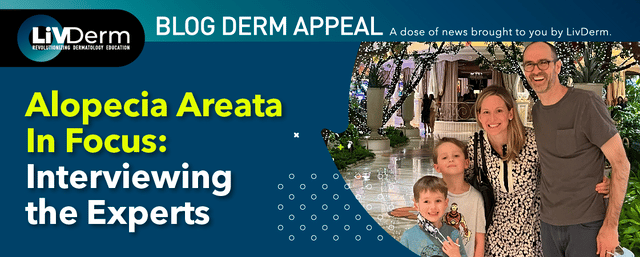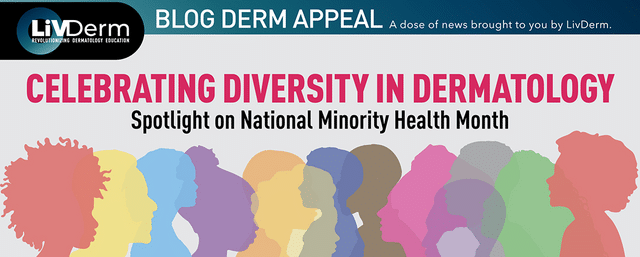September is Alopecia Areata Awareness Month and what better way to observe this than to gain invaluable insight from two of the most respected and knowledgeable providers in the field, Brett A. King, MD, PhD, and Brittany G. Craiglow, MD? These two powerhouse physicians who see patients every day, have been published in countless articles about the recent big strides in the industry for hair loss and are not only hair loss and JAK Inhibitor experts, but both also form part of LiVDerm’s exceptional faculty. One of our favorite things about them is that these two powerhouses are actually MARRIED. In this week’s Derm Appeal blog, Drs. King and Craiglow share how they got here, their knowledge, insight, and research on the topic of hair loss, pledging their continued dedication to research and care for their alopecia areata patients. They also share how they juggle their day-to-day and what is most important – their boys.
LiVDerm: With the recent approval of a novel therapeutic to treat alopecia areata and emerging data for oral minoxidil for androgenic alopecia, what does the future of alopecia management look like?
Dr. King and Dr. Craiglow: These developments are hugely important because we are talking about being able to treat the 2 most common forms of hair loss, and all of us in dermatology see patients with this condition every week. There is excitement about finally being able to help patients with these conditions.
LiVDerm: As faculty members of both the South Beach Symposium and Masters of Pediatric Dermatology, you cover the spectrum of patients from infants to older adults. What are some commonalities you share in your approach to providing care, regardless of a patient’s age?
Dr. Craiglow: One of my guiding principles is to always be sure I am treating the patient – not simply the disease, not myself, and in the case of children, not their parents. A big part of that is understanding their experience of the disease and acknowledging and validating their feelings. Unfortunately, many people with alopecia feel dismissed, hearing comments like, “it’s just hair,” and “at least you’re not sick,” but hair loss is a really big deal for almost everyone – it’s normal for it to be upsetting — devastating even. Just because it could be worse doesn’t mean that one’s experience should be minimized. In terms of treatment, there is no one-size-fits-all therapy, and our job is to present options, including their associated risks and benefits, in order to reach a shared decision with our patients and families.
LiVDerm: As parents of two small children, do you see parts of your profession in your home life? For instance, are your kids more cognizant than their peers about using sunscreen or showing any inclinations towards an interest in medicine?
Dr. King and Dr. Craiglow: Yes, for sure! Our 6-and 8-year-old sons not only pronounce “alopecia areata” and “vitiligo” perfectly, but they have gotten really good at recognizing these conditions, too. They know the differences between types of alopecia and just last night one of them explained that I (BK) have “regular hair loss, which is not the same as alopecia areata.” They complain a lot about wearing sunscreen but at the end of the summer are the palest kids around. Their aversion to photos in medical journals and boredom with our conversations about work would indicate that they probably will not be doctors when they grow up.
LiVDerm: Speaking of your children, what does a typical day look like, and what does it look like when you speak at national conferences? Do you bring your children? Do they think of it as sort of a vacation, or do they know you are working?
Dr. King and Dr. Craiglow: We both travel a lot to give talks, but with rare exceptions one of us is home every night with our sons for dinner and bedtime. We minimize work that keeps us from being home together on weekends. And we sometimes bring them to meetings, such as to the recent South Beach Symposium and Masters of Pediatric Dermatology in Miami Beach, which has been so much fun for them. They do, however, know when we are working or not, and in fact just the other day asked when we could take a vacation that was not also a meeting!
LiVDerm: Explain a bit about your therapeutic wheelhouses (JAK inhibitors, minoxidil, finasteride), how you developed an interest in them, and which patients are most likely to benefit from each.
Dr. King: It started with the first patient with AA who I treated with the JAK inhibitor tofacitinib. The case report of his treatment made news around the world and people came from all over. Subsequently, I showed successful treatment of patients with AD and vitiligo, and other conditions. It became clear to me that JAK inhibitors had unmatched potential to make so many skin diseases better.
Treating hundreds of people with AA with JAK inhibitors, which don’t always work, I needed another tool, and I found oral minoxidil. There was a clinical trial published in 1987 showing that oral minoxidil was effective as monotherapy for about 20% of patients with AA. It really does work, sometimes by itself, and both Britt and I think that it is synergistic in combination with JAK inhibitors!
Dr. Craiglow: As Brett describes, this all happened really organically. Neither of us set out to be “hair people” – in fact, I actually have a vivid memory of being a resident and telling an attending that I didn’t want to specialize in hair loss! But after that first paper made a splash, we began to realize quickly what a huge unmet need there was, and it all just snowballed from there.
LiVDerm: Would you say that alopecia is a condition where medical and aesthetic dermatology intersect? Is it more one than the other?
Dr. King and Dr. Craiglow: Alopecias and their treatment are largely medical dermatology. The care of patients with different alopecias is not about trying to get “better” or “bigger” hair, but rather restoring normal when there is a distortion of appearance, which can be severe when hair is erased from one’s head.
LiVDerm: Is some degree of hair loss (particularly in men) simply a fact of life, or with novel therapeutics would you say that it no longer has to be?
Dr. King and Dr. Craiglow: For now that seems to be true, but it likely won’t always be. We are making huge strides in the treatment of androgenic alopecia, and the future is bright. We just need to try.
















